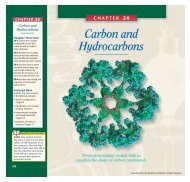Create successful ePaper yourself
Turn your PDF publications into a flip-book with our unique Google optimized e-Paper software.
Section 9-1<br />
Demonstration 1<br />
Volume of liquids<br />
and gases<br />
Purpose Demonstrate that,<br />
unlike gases, liquids have a definite<br />
volume and cannot be significantly<br />
compressed.<br />
Materials large syringe, large<br />
eyedropper, or turkey baster<br />
Procedure Pull the piston to<br />
about half the tube’s length, letting<br />
air into the syringe. Hold<br />
your finger tightly over the opening<br />
and pull back as far as possible.<br />
Read the scale marking at<br />
the piston level. Now push back<br />
as far as possible. Have a student<br />
record the air volume on the<br />
chalkboard for each case. Point<br />
out that no air has been let into<br />
or out of the cavity, but the same<br />
amount of air occupies all the<br />
space that is available. Next, fill<br />
the syringe halfway <strong>with</strong> water<br />
and repeat. Let a student in class<br />
try to compress it.<br />
Using the eyedropper, show<br />
that the volume of air that equals<br />
that of the bulb and the pipe can<br />
easily be reduced to the volume<br />
of the pipe by squeezing the bulb<br />
while holding the opening tightly<br />
sealed. Fill the eyedropper <strong>with</strong><br />
water and record the water level.<br />
Holding the end sealed while<br />
squeezing will demonstrate that<br />
the air volume is reduced, while<br />
the water level remains the same.<br />
318<br />
9-1 SECTION OBJECTIVES<br />
• Define a fluid.<br />
• Distinguish a liquid from a<br />
gas.<br />
• Determine the magnitude of<br />
the buoyant force exerted on<br />
a floating object or a submerged<br />
object.<br />
• Explain why some objects<br />
float and some objects sink.<br />
fluid<br />
a nonsolid state of matter in<br />
which the atoms or molecules are<br />
free to move past each other, as<br />
in a gas or a liquid<br />
Figure 9-1<br />
Both (a) liquids and (b) gases are<br />
fluids because they can flow and<br />
change shape.<br />
318<br />
Chapter 9<br />
9-1<br />
<strong>Fluid</strong>s and buoyant force<br />
DEFINING A FLUID<br />
Matter is normally classified as being in one of three states—solid, liquid, or<br />
gaseous. Up to this point, this book’s discussion of motion and its causes has<br />
dealt primarily <strong>with</strong> the behavior of solid objects. This chapter concerns the<br />
mechanics of liquids and gases.<br />
Figure 9-1(a) is a photo of a liquid; Figure 9-1(b) shows an example of a<br />
gas. Pause a moment and see if you can identify a common trait between<br />
them. One property they have in common is the ability to flow and to alter<br />
their shape in the process. Materials that exhibit these properties are called<br />
fluids. Solid objects are not considered to be fluids because they cannot flow<br />
and therefore have a definite shape.<br />
Liquids have a definite volume; gases do not<br />
Even though both gases and liquids are fluids, there is a difference between<br />
them: one has a definite volume, and the other does not. Liquids, like solids,<br />
have a definite volume, but unlike solids, they do not have a definite shape.<br />
Imagine filling the tank of a lawn mower <strong>with</strong> gasoline. The gasoline, a liquid,<br />
changes its shape from that of its original container to that of the tank. If there<br />
is a gallon of gasoline in the container before you pour, there will be a gallon<br />
in the tank after you pour. Gases, on the other hand, have neither a definite<br />
volume nor a definite shape. When a gas is poured from one container into<br />
another, the gas not only changes its shape to fit the new container but also<br />
spreads out to fill the container.<br />
(a) (b)<br />
Copyright © by Holt, Rinehart and Winston. All rights reserved.
















